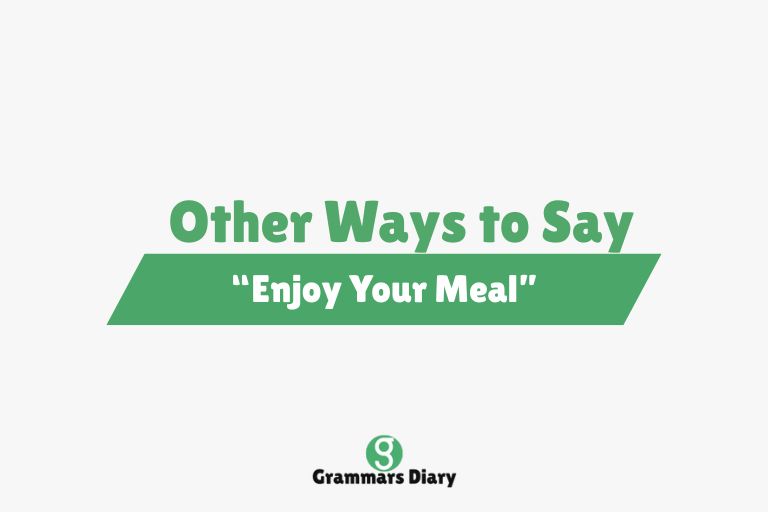“Enjoy your meal” is one of those go-to phrases we use when someone’s about to eat, whether it’s at the dinner table, in a restaurant, or during a casual lunch break with friends. It’s simple, polite, and gets the point across—but what if you want to say it differently, maybe a bit more creatively, warmly, or formally, depending on the setting?
This article explores twenty alternative expressions that can replace “Enjoy your meal,” giving you a richer and more varied vocabulary for mealtime conversations. Whether you’re looking to elevate a restaurant experience, make a dinner party feel more special, or just want a new way to wish someone a good bite, these alternatives will come in handy.
Other Ways to Say “Enjoy Your Meal”
1. Bon Appétit
Example: “Bon appétit, everyone. Hope you love the flavors tonight.”
Meaning: A French phrase meaning “good appetite.” It’s a classic and widely understood expression often used in formal dining or upscale settings.
Usage: Ideal when you want to sound elegant or refined; works well in both English and French-speaking environments.
2. Dig In
Example: “Dinner’s ready—dig in while it’s hot.”
Meaning: An informal phrase encouraging people to start eating. It adds warmth and enthusiasm, implying that the food is inviting and plentiful.
Usage: Best suited for casual meals among friends or family where comfort and ease are key.
3. Tuck In
Example: “Everything’s on the table, so tuck in!”
Meaning: A British informal phrase that tells someone to begin eating heartily.
Usage: Great for laid-back, cozy meals, especially in households or among close friends.
4. Chow Down
Example: “Grab a plate and chow down!”
Meaning: An American slang expression that suggests enthusiastic eating.
Usage: Works well in playful or humorous contexts, such as BBQs, casual parties, or food truck events.
5. Feast Well
Example: “The spread looks amazing—feast well, everyone.”
Meaning: A slightly poetic alternative that emphasizes abundance and enjoyment.
Usage: Perfect for festive or celebratory meals, like holiday feasts or weddings.
6. Enjoy Every Bite
Example: “I made this with love—enjoy every bite.”
Meaning: A warm and personal phrase that emphasizes appreciation for the food and the effort behind it.
Usage: Ideal for home-cooked meals or when serving someone special.
7. Here’s to a Great Meal
Example: “Here’s to a great meal and even better company.”
Meaning: A toast-like phrase that combines well wishes for both the food and the dining experience.
Usage: Suitable for semi-formal or friendly gatherings where a shared moment is appreciated.
8. Savor the Flavors
Example: “Take your time and savor the flavors.”
Meaning: Encourages mindfulness while eating and paying attention to taste and texture.
Usage: Excellent for foodies, tasting menus, or slow-dining experiences.
9. Let the Feast Begin
Example: “Everything’s ready—let the feast begin!”
Meaning: A lively and dramatic way to kick off a meal, especially one with many courses or guests.
Usage: Perfect for special events like Thanksgiving, Eid, or banquet-style dinners.
10. May Your Meal Be Delightful
Example: “Thank you for joining us—may your meal be delightful.”
Meaning: A courteous and slightly formal way to express your hope that the food is pleasing.
Usage: Ideal for hosts at dinner parties or restaurant staff addressing guests.
11. Hope You Like It
Example: “I tried something new with the spices—hope you like it.”
Meaning: A modest, informal way to express your desire for the person to enjoy what you’ve prepared.
Usage: Common in casual home settings when sharing a meal you’ve cooked yourself.
12. Happy Eating
Example: “Plenty to go around—happy eating!”
Meaning: A cheerful, friendly way to encourage enjoyment of the meal.
Usage: Great for relaxed gatherings, potlucks, or picnic-style settings.
13. Grub’s Up
Example: “Come and get it—grub’s up!”
Meaning: A playful phrase indicating that the food is ready and it’s time to eat.
Usage: Popular in American slang, often used in family meals or informal group settings.
14. Eat Up
Example: “Don’t wait for me—eat up while it’s warm.”
Meaning: A simple way to say that it’s time to eat, often used when someone’s hesitant to start.
Usage: Suitable for both casual and familial conversations.
15. Indulge Yourself
Example: “It’s your favorite dish—indulge yourself.”
Meaning: Suggests that the person should allow themselves the pleasure of enjoying the food without restraint.
Usage: Works well in fine dining or when treating someone to a special meal.
16. Treat Yourself
Example: “You’ve had a long day—treat yourself to a big helping.”
Meaning: A modern, often trendy phrase that invites someone to enjoy something indulgent or comforting.
Usage: Very common in cafes, dessert spots, or after a stressful day.
17. Have a Delicious Time
Example: “The chef went all out—have a delicious time.”
Meaning: Combines the ideas of having fun and enjoying the food at once.
Usage: Excellent for semi-formal dinners, food tours, or chef-hosted events.
18. Relish Your Meal
Example: “Relish your meal and the quiet of the evening.”
Meaning: Encourages not just eating but appreciating the full experience of dining.
Usage: Ideal for more thoughtful or romantic settings.
19. May It Satisfy You
Example: “A simple dish, but may it satisfy you.”
Meaning: A humble and sincere wish that the food meets the person’s needs or tastes.
Usage: Fits well in spiritual, minimalist, or gratitude-centered meals.
20. Wishing You a Pleasant Meal
Example: “On behalf of our staff, we’re wishing you a pleasant meal.”
Meaning: A professional and courteous way to send good wishes for the dining experience.
Usage: Most often used in hospitality, especially in restaurants, hotels, or airlines.
When to Use Different “Enjoy Your Meal” Alternatives
In Formal Dining
In more refined or high-end settings, using expressions like “Bon appétit,” “Relish your meal,” or “Wishing you a pleasant meal” adds a layer of etiquette and class. These alternatives show consideration for the tone of the environment and add to the dining experience without sounding too casual.
In Casual or Friendly Settings
Expressions like “Dig in,” “Hope you like it,” or “Grub’s up” feel more relaxed, personal, and friendly. They’re perfect when sharing meals with loved ones at home, during barbecues, or informal dinners, where warmth and informality take center stage.
In International or Cultural Contexts
Many cultures have their own traditional ways of expressing this sentiment. Phrases like “Bon appétit” (French) or “Tuck in” (British) might carry charm or cultural relevance. Being mindful of cultural nuances adds depth and respect to your conversation.
Conclusion
“Enjoy your meal” is just the tip of the iceberg when it comes to expressing mealtime wishes. As we’ve explored, there are many ways—some playful, some poetic, some professional—to convey the same sentiment with a little extra color, charm, or context. By switching things up based on who you’re with and where you are, you can turn a simple phrase into something far more memorable.
FAQs
What does “Enjoy your meal” mean?
It’s a polite way to wish someone a pleasant and satisfying eating experience.
Is “Bon appétit” formal or informal?
It’s considered elegant and slightly formal, but still very common and friendly in tone.
Can these alternatives be used in professional restaurant settings?
Yes, especially expressions like “Wishing you a pleasant meal,” “May it satisfy you,” or “Bon appétit,” which maintain professionalism while enhancing hospitality.
Which phrases are best for casual use?
“Dig in,” “Chow down,” and “Hope you like it” are great for relaxed, friendly meals.
How can I make my mealtime wish more personal?
Try using phrases like “Enjoy every bite” or “Treat yourself,” which feel more intimate and thoughtful.











